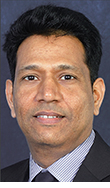Faculty to develop sustainable material for 3-D printed buildings

Zofia Rybkowski

Manish Dixit

Negar Kalantar
To prepare for a sustainable future in which structures are built with large-scale 3-D printers, a team led by Texas A&M College of Architecture faculty is developing and testing environmentally responsible printing materials and methods in a two-year study funded by a $500,000 X-Grant from the Texas A&M [President’s Excellence Fund] (https://president.tamu.edu/initiatives/index.html) .
It will soon be commonplace for bridges, roads and buildings to be constructed with 3-D printing technology, said study leader Zofia Rybkowski, associate professor of construction science.
“Large-scale 3-D printing offers tremendous construction advantages, such as enhanced worker safety, smaller staging requirements, and remotely controlled construction, which is beneficial in hostile environments like war zones, jungles and for building on other planets,” said Rybkowski.
On the other hand, given that concrete production is already responsible for 5-7% of global carbon dioxide emissions, she said the widespread adoption of printed concrete and resulting jump in greenhouse gas emissions has the potential to worsen climate change.
To address this concern, the project team is developing carbon neutral 3-D printing material, or pastes, that can capture and remove CO 2 from the atmosphere.
Additionally, the College of Architecture team will explore how 3-D concrete can be shaped to carry more weight, improve ventilation and enhance its stability.
“Using the same building material in multiple ways enhances recyclability because the structure can be ground down and reprinted after it becomes obsolete,” Rybkowski said. “This is an improvement over current practice where materials from demolished structures typically end up in landfills.”
The research team also includes Manish Dixit, assistant professor of construction science; Negar Kalantar, assistant professor of architecture; Bjorn Birgisson, professor of civil engineering; Sarbajit Banerjee, professor of chemistry; and Paul Schwab, professor of soil and crop science.
The project is one of 10 teams chosen for funding as part of the first year of the X-Grant program, which will encourage research across disciplines on topics facing global society.
Sarah Wilson
swilson@arch.tamu.edu
Tags
- architecture
- building a better texas
- construction science
- feature
- interdisciplinary
- research
- rss
- sustainability
- technology
Related Posts

Faculty envision 3-D printing’s future, earn ‘Vision Award’

Summit explored education advances with ‘smart’ cities

Texas A&M researchers enabling buildings to ‘breathe’

Essay highlights professor emeritus’ social activism

Oct. 23 symposium spotlighted college, faculty research
Follow Us
Facebook Twitter Vimeo Youtube Flickr RSS
Recent Posts

Planning prof heads study of disaster housing aid

A message from the dean

Former student remembered as expert planner

Leading educator named new head of Architecture Dept.





_thumbnail_small.png)
